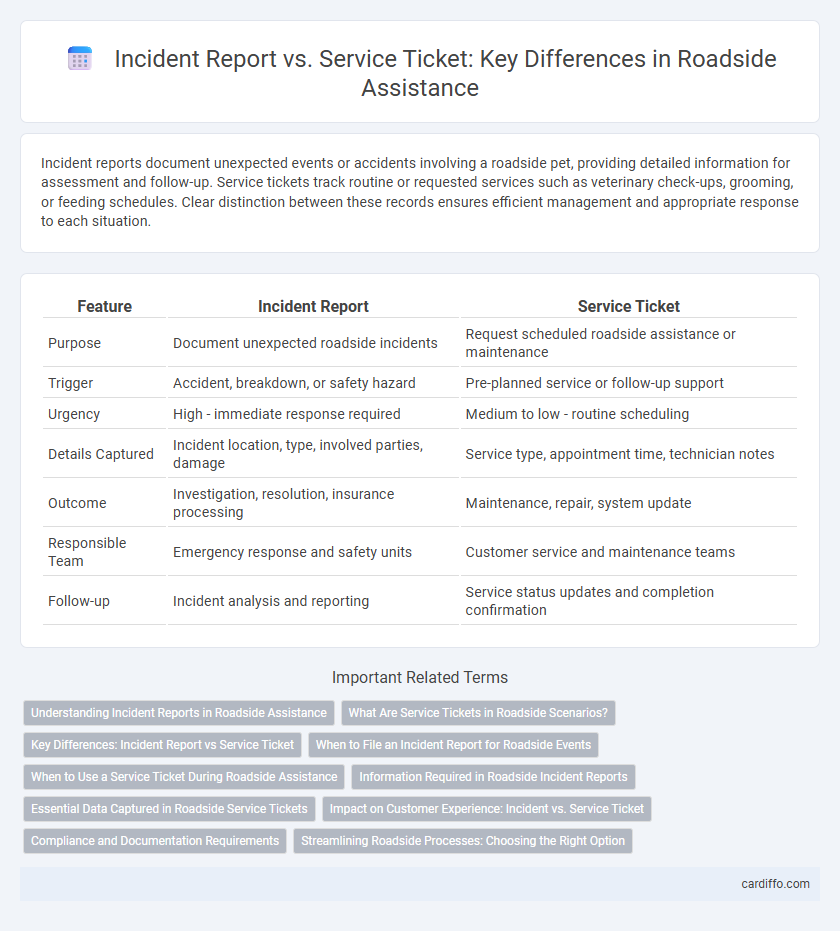Incident reports document unexpected events or accidents involving a roadside pet, providing detailed information for assessment and follow-up. Service tickets track routine or requested services such as veterinary check-ups, grooming, or feeding schedules. Clear distinction between these records ensures efficient management and appropriate response to each situation.
Table of Comparison
| Feature | Incident Report | Service Ticket |
|---|---|---|
| Purpose | Document unexpected roadside incidents | Request scheduled roadside assistance or maintenance |
| Trigger | Accident, breakdown, or safety hazard | Pre-planned service or follow-up support |
| Urgency | High - immediate response required | Medium to low - routine scheduling |
| Details Captured | Incident location, type, involved parties, damage | Service type, appointment time, technician notes |
| Outcome | Investigation, resolution, insurance processing | Maintenance, repair, system update |
| Responsible Team | Emergency response and safety units | Customer service and maintenance teams |
| Follow-up | Incident analysis and reporting | Service status updates and completion confirmation |
Understanding Incident Reports in Roadside Assistance
Incident reports in roadside assistance document detailed accounts of events such as vehicle breakdowns, accidents, or service delays, capturing key information like location, time, and nature of the incident. These reports prioritize accuracy and completeness to facilitate effective response coordination and future analysis. Compared to service tickets, incident reports focus more on the factual sequence and impact, serving as critical records for liability and quality assurance.
What Are Service Tickets in Roadside Scenarios?
Service tickets in roadside scenarios are digital or physical records created to document service requests or maintenance tasks performed on vehicles during roadside assistance. These tickets capture essential details such as the type of service rendered, location, time, and technician information, enabling efficient tracking and resolution of incidents. Unlike incident reports that focus on the event causes and damages, service tickets prioritize task management and workflow completion for roadside repairs and support.
Key Differences: Incident Report vs Service Ticket
An Incident Report documents an unexpected event or accident on the roadside that requires investigation or formal recording, while a Service Ticket tracks the request for roadside assistance or repair services. Incident Reports focus on detailed accounts of the incident, including cause and impact, whereas Service Tickets prioritize service delivery timelines and resolution status. Understanding these key differences helps streamline roadside management and ensures accurate tracking of incidents and service interventions.
When to File an Incident Report for Roadside Events
Filing an incident report for roadside events is essential when there is significant property damage, personal injury, or a traffic violation that requires official documentation. Incident reports provide comprehensive details for law enforcement and insurance purposes, unlike service tickets which primarily track service requests or repairs. Timely incident reporting ensures accurate record-keeping and legal compliance following accidents or hazardous road conditions.
When to Use a Service Ticket During Roadside Assistance
A service ticket should be used during roadside assistance when documenting specific repair or maintenance services performed on a vehicle, ensuring accurate tracking of tasks and costs. Incident reports are typically reserved for recording the details of unexpected events or accidents that occur during the service. Utilizing service tickets streamlines billing and facilitates clear communication between service providers and customers in the roadside assistance industry.
Information Required in Roadside Incident Reports
Roadside incident reports require detailed information such as the exact location of the incident, the time and date it occurred, and a description of the event including vehicle and driver details. Essential data also includes the nature of the roadside assistance needed, damage assessment, and any injuries reported. Accurate documentation of these elements ensures efficient service ticket creation and timely response.
Essential Data Captured in Roadside Service Tickets
Roadside service tickets capture essential data including incident location, vehicle identification number (VIN), service type, and timestamps for arrival and completion to ensure precise tracking of roadside assistance activities. Detailed descriptions of the issue reported, parts used, and technician notes provide critical insights for efficient resolution and future reference. This structured data enhances accountability, supports billing accuracy, and contributes to performance analysis within roadside assistance operations.
Impact on Customer Experience: Incident vs. Service Ticket
Incident reports document unexpected events or disruptions during roadside assistance, highlighting immediate customer safety and service interruptions that demand rapid resolution to minimize stress and inconvenience. Service tickets track scheduled or routine maintenance services, ensuring transparent communication and timely completion, which enhances customer trust and satisfaction. The clarity and responsiveness in handling incidents versus service tickets directly influence the overall customer experience by balancing emergency response efficiency with proactive service management.
Compliance and Documentation Requirements
Incident reports provide detailed documentation of roadside events, ensuring compliance with safety regulations and legal standards by capturing precise data such as time, location, and involved parties. Service tickets focus on the fulfillment of repair or assistance tasks, documenting the services performed, parts used, and technician details to comply with company policies and warranty requirements. Maintaining both records accurately supports accountability and regulatory audits in roadside operations.
Streamlining Roadside Processes: Choosing the Right Option
Incident reports document specific events during roadside assistance, capturing critical details like location, time, and nature of the issue for accurate record-keeping and liability management. Service tickets focus on the operational workflow, tracking tasks such as dispatch, service completion, and follow-up actions to ensure efficient resource allocation and timely resolution. Streamlining roadside processes requires selecting between incident reports for detailed event analysis and service tickets for managing service delivery, optimizing both documentation and operational efficiency.
Incident Report vs Service Ticket Infographic

 cardiffo.com
cardiffo.com